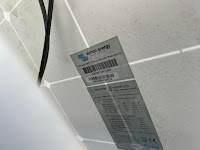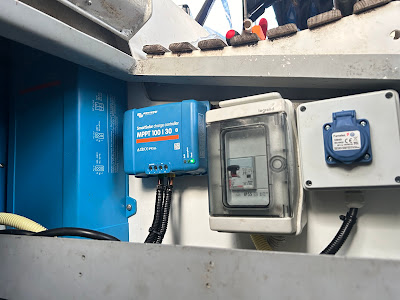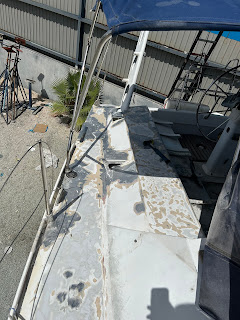I must learn to embrace painting.
Links to assist in doing a better job….
Whatever the anti-skid is, it was very hard, and could only be removed with a grinder. Hot, dusty work.
do not enjoy painting. Anything.



The deck coatings were in terrible condition, The top layer was peeling in places and oxidized everywhere else, and the base layers was failing in places, particularly adjacent to hardware. In some cases there was pitting evident, the worst of which was around the hinges on the anchor locker hatches. The poor paint condition was Sakura's most obvious deficiency and is the single biggest remaining refit task, so I began to address this in August 2024.
I decided to tackle the more complex areas first, particularly those requiring hatch and hardware removal/replacement. This meant the bow, the cabin top aft of the mainsheet traveller, and the transom and aft end of the cockpit. As of September 2024. the area painted may represent about 25% of the total deck area. Much of the remainder is open deck space and is more straightforward.
The paint was applied with brush and roller in 35 deg heat, in a dusty boatyard. Less than ideal but the initial results were encouraging. I painted at the beginning and end of day to avoid the most intense heat and sun.
The paint system ended up being all International products. with Primocon or interprotect 200e as primers and Interthane 990 as the finishing coat. For non-skid I will likely use Kiwigrip.
Removal of hardware
Removing the hardware requires some technique and patience, good screwdrivers, penetrating oil, a blowtorch, and impact driver, and if all else fails a good centrepunch, quality drill bits and a good quality drill that can operate in heat at low speed without self-destructing. Hurrying takes longer.
The hardware was typically insulated from the deck some kind of adhesive material with a layer of plastic - about the thickness of heavy (10 mil?) electrical tape. I replaced this with sheet rubber on hinges and latches, and fibreglass sheet (laid up in my shop at home) cut to shape. The rubber was a bad idea. Too stretchy. I made some more sheet fiberglass, and had to re do 5)3 hinges and latches. Thanks Robert. . Hurrying takes longer. The sheet fibreglass was perfect. Butyl tape was used for bedding/sealing and tefgel was applied to both the tapped hole and fasteners.


Preparation of existing surfaces.
To start, I scrubbed the area with a cleaning/de-greasing soluton. I found that an angle grinder with 80 then 120g disks was the best way to remove the thick non skid coating and to remove any mild pitting. I then learned that one of these silicon/fibreglass tools is as good or better for the first pass.

I did use a wire scratch wheel, and while it helps for certain things, it is not the best, and is certainly more dangerious than I realized. (I found many bristles embedded in various locations on my unprotected self hours later, like forgotten accupuncture needles. Thankfully no harm done) Due to the thick buildup of coatings and filler, this sanding generated gallons of dust. A real mask, goggles and lighweight coverals are essential. The yard guys weare a balaclava type hood as well. I wore a hat.
Random pics below.










.JPG)
.JPG)



























































